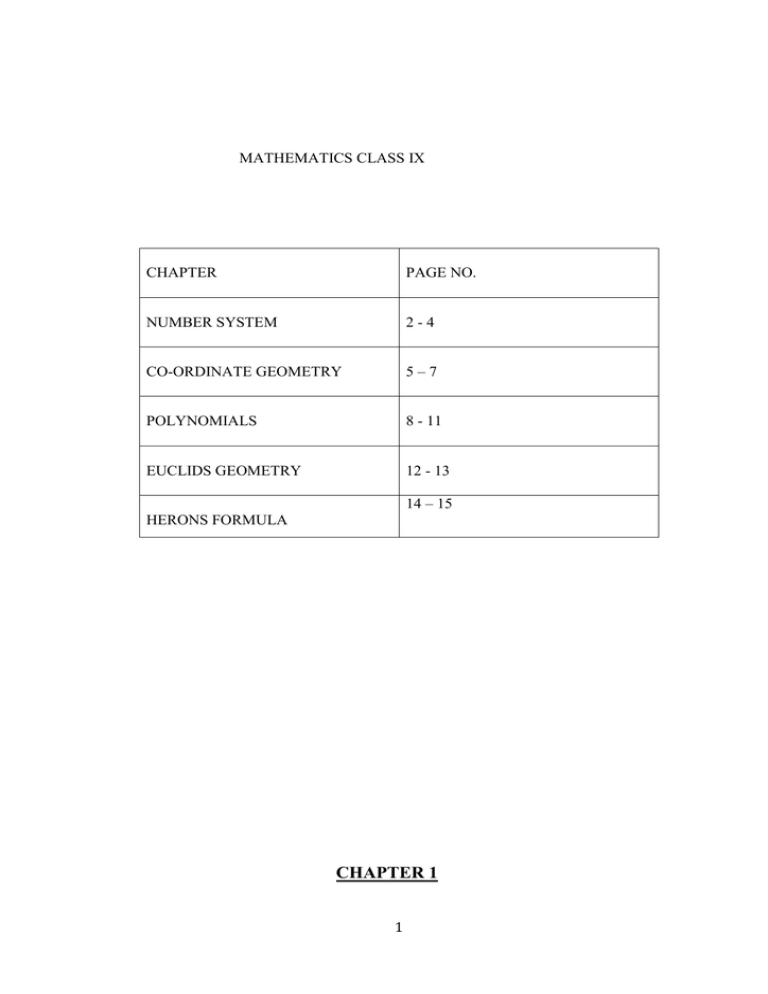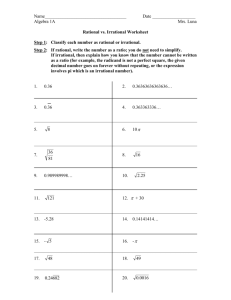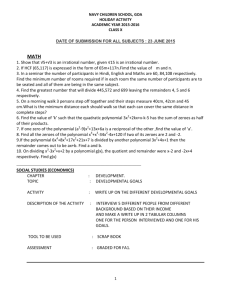Document
advertisement

MATHEMATICS CLASS IX CHAPTER PAGE NO. NUMBER SYSTEM 2-4 CO-ORDINATE GEOMETRY 5–7 POLYNOMIALS 8 - 11 EUCLIDS GEOMETRY 12 - 13 14 – 15 HERONS FORMULA CHAPTER 1 1 NUMBER SYSTEMS (1 Mark) 1. Rational number -5/9 is also a __________ number. 2. Decimal expansion of 3/21 is _____________. 3. p/q form of 0.3 is _____________. 4. (-5 + 2 √5 - √5) is a _______________ number. (Rational/Irrational) 5. (16) ¾ = _______________. 6. An irrational number between 1.011243……and 1.012243……. is _________________. 7. Every point on a number line can be associated with a ____________ number. 8. Rationalizing factor of √7 + √2 is ______________. 9. The sum of a rational number and an irrational number is always a _______________ number. 10. Decimal expansion of a rational number cannot be _____________. 11. Every integer is a ___________ number. (True/False) 12. (27)2/3 = __________________. 13. x (a-b) x(b-c) x (c-a) = _________________. 14. The number (√5 + √3)2 is a ______________ number. 15. Π is an ____________ number. 16. _________________ numbers can be inserted between 1/7 and 8/7. 17. √10 x √25 = __________________. 18. If 4 √49 = x ½, then the value of x is ______________. 19. The value of (√25 - √21) ( √25+ √21) = _________________. 20. ∜(∛22)= __________________. 2 (2 Marks) 21. What type of a number is √5, Rational or irrational, Why? 22. Find 4 irrational numbers between √2 and √3. 23. What type of a decimal is 12/15? Why? 24. Is it true to say that all real numbers are rational numbers? Why? 25. Give an example to show that sum and product of two irrational numbers is a rational number. 26. Find the value of (32/243) 4/5. 27. Simplify by rationalizing the denominator- 28. Express 18.4848…. as p/q. 29. Represent √6 on the number line. 30. Insert a rational and an irrational number between -2/5 and ½. √5 √7− √3 (3 Marks) 1 31. If x = 9 - 4√5, find the value of x2 + 𝑥2. 32. If x = √2+ 1, the find the value of (x –𝑥)2. 33. Visualize 3.7659 on the number line. 34. Simplify by rationalizing the denominator- 6+4√2 35. Express as p/q - 3.235235…… 36. Represent √7.3 on the number line. 37. If a= 2+ √3, the find the value of a − 38. If a= 7-4√3, find (√a+√𝑎). 39. Express 2.5434343……. as p/q. 1 6−4√2. 1 3 1 𝑎 40. 3+ √2 Find the values of a and b if 3− √2= (a+b)√2. (4 marks) 1 2 1 41. Prove that 2+ √3 + 42. Evaluate 27(-1/3) . 27(-1/3) x [27(1/3)- 27(2/3)] 43. Prove that) (231 + 230 44. Classify the following numbers as rational or irrational with justification3√18 -√0.4 (a) (b) (c) (d) 45. √5− √3 (230 + 229 + 2 28 - 229 + 2− √5= 0 7 =10. √279 10.124124…… Express with rational denominator - 1 √2+√3+√5 ANSWERS 1 MARK 1) Real 7) Real 11) True 17) 5 √10 2) Non terminating repeating 3) 1/3 4) Rational 5) 8 8) √7-√2 9) Irrational 10) Non terminating Non repeating 12) 9 13) 1 14) Irrational 15) Irrational 16) Infinitely many 18) 7 19) 4 20) 2 1/6 2 MARKS. 21) Rational 23) Terminating 24) No 26) 81/16 27) (√35+√15)1/4 3 MARKS 31) 324 32) 4 34)17-12√2 35) 3232/999 37) 2√3 38) 4 39) 1259/495 40) a =11/7, b = 6/7 4 MARKS 41) -1/3 44) (a) Irrational (b) Irrational (c) Rational (d) Irrational 45) 1/12 (3√2+2√3-√30) 4 CHAPTER 3 CO-ORDINATE GEOMETRY (1 mark) 1. The point (-7, 0) lies on _____________. 2. Point (2, -2) lies on the line y = -x or not. _____________. 3. The equation of x –axis is ______________. 4. Does the line y=x pass through the origin? _______________. 5. If the ordinate of a point is zero, then the point always lies ______________. 6. In which quadrant does the point (-4,-5) lie? _______________. 7. The abscissa of the point (-2,5) is _________________. 8. The ordinate of the point (0, -6) is _________________. 9. Perpendicular distance of the point (-3, 7) from y-axis is ______________. 10. Ordinate of all the points on the x-axis is ________________. 11. Abscissa of all points on the x-axis is __________________. 12. A line is drawn parallel to y-axis at a distance of 3 units. What are the coordinates of point which lies on it at a distance of 3 units below x axis.____________________. ( 2 marks ) 13. (a) (b) (c) (d) In which quadrant or axes the following points be (3, -1) (-1,0) (1,5) (-3,-5) 5 14. (a) (b) (c) (d) Plot the following points in the cartesian plane on a graph paper(-2,3) (4,0) (-1,-5) (0,-2) (3 marks) 15. Plot the points A (0,3), B (5,3) C (4,0) and D (-1,0) on the graph paper.Identify the figure obtained and find whether the point (2,2) lies inside the figure or not. 16. Plot the points (-2,3) and (-4,-2). Find their minor images with respect to both the axes. 17. Complete the following statements:(i) (ii) (iii) The coordinates of a point on the x-axis are of the form __________ and that of the point on the y axis ____________. The coordinates of a point are of the form ______________ in the first quadrants. The coordinates of a point are of a form _____________in the fourth quadrant. 18. Find the area of a triangle whose vertices are (0,4), (0,0) and (2,0) by plotting on the graph. (4 marks) 19. (i) Plot the points A (-5,3), B (3,3), C (3,0) and D(-5,0) in the cartesian plane. (ii) Name the figure ABCD (iii) Find the ratio of the areas of the two parts of ABCD in Iquadrant and II quadrant. 20. Plot the points A (-2,3) ,B (-2,0),C (2,0) and D(2,6) on the graph.Join them concecutively and find the length of AC and AD 6 ANSWERS: 1 MARK. 1) X’ axis 2) Yes 3) y=0 4) Yes 5) On the X-axis 6) III quadrant 7) -2 8) -6 9) 3 units 10) zero 11) Different 2 MARKS 13) (a) IV quadrant (b) X’ axis (c) I quadrant (d) III quadrant 3 MARKS 15) Parallelogram, yes unit2 17) (i) (X,0) , (0,y) (ii) (X,Y) (iii) (X,-Y) 18) 4 4 MARKS 19) 4 unit2 20) AC=AD=5 units CHAPTER 2 7 POLYNOMIALS (1 mark) 1. -2 is a _________________ polynomial. 2. The coefficient of x2 in the polynomial 4x3 – √ 2 x2 + 7 is __________________. 3. The degree of polynomial (y3 - 2) (y2 + 11) is _______________. 4. The degree of polynomial P (x) = 3 is ________________. 5. The degree of a zero polynomial is ___________________. 6. Is 5 a zero of the polynomial x2 – 5x + 1? _______________. (Yes/No) 7. Zeroes of the polynomial P(x) = (x-2) 2 – (x+2)2 are _______________. 8. Zero of the polynomial 2x+5 is ________________. 9. All algebraic expressions are polynomials. _____________. (True/False) 10. If a polynomial f (x) is divided by (x-a), the remainder is _____________. 11. One of the factors of (x - 1) – (x2 - 1) is ______________. 12. The coefficient of x in the product (x-1) (1-2x) is _______________. 13. What is the remainder when x3 – 2x2 + x+1 is divided by (x-1) 14. If x3+6x2+4x+k is exactly divisible by x+2, then k = ____________. 15. Is 2 a zero of the polynomial 2x3-3x2-17x+30? _________________. (2 Marks) 16. Evaluate by using suitable identity - 211 x 189 17. If (x-1) is a factor of the polynomial p(x) = 3x4 – 4x3 – ax+ 2, then find the value of a. 8 18. 19. Without actual multiplication, find the value of (17)3+ (-12)3 + (-5)3. Find the coefficient of x in the expansion of (x+3)3. 20. Find the value of k, for which the polynomial x3 – 3x2 + 3x + k, has 3 as its zero. 21. Find the value of a for which (x-1) is a factor of a polynomial a2x3 – 4ax + 4a -1. 22. Find the value of p for which the polynomial 2x4 + 3x3 + 2Px2 + 3x + 6 is exactly divisible by (x+2). 23. Factorize 2p (a-b) + 3q(5a – 5b) + 4r (2b-2a) (a-b) (2p+15q-8r) 24. Factorize: 27P3 - 216 - 2P2 + ¼ P 25. If the polynomials 2x5 + mx2 + 3x – 5 and x3+x2-4x+m leaves the same remainder when divided by x-2, then find the value of m. 26. Factorize: x2 + 3√2x + 4. 27. For what value of a is (x-5) a factor of x3-3x2+ax-10. 1 9 (3 Marks) 28. Factorize: 8x3 + y3 + 27z3 – 18 xyz. 29 Factorize: (x - y)3 + (y-z)3 + (z-x)3 30. Find the remainders when 3x3 – 4x2 + 7x – 5 is divided by (x-3) and (x + 3) 31. If x = 2y + 6, find the value of x3 – 8y3 – 36 xy – 216 32. Factorize: x2 + (x/4) – (1/8) 33. Factorize: (1/27)x3 – y3 + 125 z3 + 5xyz 34. If the polynomial x3 +mx2 + nx + 6 has x-2 as a factor and leaves remainder 3 when divided by x- 3, find the values of m & n. 35. Simplify: (5a + 3b)3 – (5a – 3b) 3 36. Factorize: 8x3 – (2x - y)3 37. Factorize: 12 (x2 + 7x)2 – 8 (x2 + 7x) (2x - 1) – 15 (2x - 1)2 38. Show that 2 & -1/3 are the zeroes of the polynomial 3x3 – 2x2 – 7x – 2. 9 39. Factorize: (x2 – 2x)2 – 11(x2 – 2x) + 24 (4 Marks) 40. The volume of a cylinder is given by the polynomial P (x) = 8x3 – 36x2 + 54 x – 27. Find the possible expression for the side of the cube. Verify it when side of the cube is 3 cm. 41 Prove that – (a2 – b2)3 + (b2-c2)3 + (c2 – a2)3 = 3 (a+b) (b+c) (c+a) (a-b) (b-c) (c-a) 42. If the remainder is same when polynomial P (x) = x3+8x2+17x+ax is divided by (x+2) and (x+1), fnd the value of a. 43. Find if (x + 1) and (x + 2) are the factors of x3+3x2-2α x +β 44. Factorize: x3 – 3x2 – 9x – 5. 45. The polynomial P(x) = x4-2x3+3x2-ax+3a-7 when divided by (x+1) leaves remainder 19. Find the values of a. Also find the remainder when P (x) is divided by x+2. 46. Show that x3+y3+z3-3xyz = ½ [(x+y+z) (x-y)2 + (y-z)2 + (z-x)2 ] 47. Prove that (x+y)3 + (y+z)3 + (z+x)3 – 3 (x+y) (y+z) (z+x) = 2 (x3+y3+z3 – 3xyz) 48. Show that 2 and -3/2 are the zeroes of the polynomial 4x3 + 20x2 + 33x + 18. Also find the zero of the polynomial. 49. Without actual division, prove that- 4x4 – 2x3 – 6x2 + x + 1 is divisible by 2x2 + x -1. 50. If x+y+z = 6, find the value of (2-x)3 + (2-y)3 + (2-z)3 – 3 (2-x) (2-y) (2-z) 51. Without actual division, prove that 2x4 – 8x3 + 3x2 + 12x – 9 is exactly divisible by x2 – 4x +3. 52. Factorize: x3+6x2+11x+6. ANSWERS: 1 MARK 1) Constant 2) -√2 3) 5 4) 0 5) Not defined 6) No 7) -4,2 8) -5/2 10 9) False 10) f(a) 11) x-1 12) 3 13) 1 14) -8 15) Yes 2 MARKS 16) 39879 17) -1 18) 3060 19) 27 20) -9 21) a=1,-1 22) -1 23) (a-b) (2p+15q- 8r) 24) (3p-1/6)3 25) -13/3 26) (x+2√2) (x+√2) 27) -8 3 MARKS 28) (2x+y+3z) (4x2+y2+9z2-2xy-3yz-6xz) 29) (3-y) (y-z) (z-x) 30) 61, 143 31) 0 32) (x+1/2) (x-1/4) 33) (1/3x-y+5z) (1/9x2+y2+25z2+1/3xy+5yz-5/3zx) 34) m= -3, n= -1 35) 66(75a2+9b2) 36) (y) (12x2-6xy+y2) 37) (2x2+x+3)(6x2+52x-5) 39) (x-4) (x+2) (x-3) (x+1) 4 MARKS 40) (2x-3) 42) 0 43) α = -1, β = 0 44) (x-5) (x+1) (x+1) 45) a=5,62 48) -3/2 50) 0 52) (x+1) (x+2) (x+3) CHAPTER 5 11 INTRODUCTION TO EUCLIDS GEOMETRY (1 Mark) 1. The geometry of Vedic period originated from the construction of __________________. 2. The first known proof that “the circle is bisected by its diameter” was given by ________________. 3. An undefined term, represented by a dot defines a _________________. 4. The number of Euclid’s postulate is __________________. 5. In ancient India, the manuals of geometric construction were _______________. 6. Proved statement based on deductive reasoning, by using postulates and axioms is known as _______________ theorem. 7. If a point C lies between two points A and B such that AC=BC, then the value of AC is _________________. 8. If lines PQ, PR, PS and PT are parallel to a line l, what can be said about the points P,Q,R,S and T? 9. In the given figure, if AC=BD then AB = _________________. A B C D 10. If l, m and n are three distinct lines such that l ll m and l ll n, then ___________________. (2 Marks) 11. On a line if there are four points A,B,C and D such that AC=BD, then show that AB=CD. State the Euclid’s postulate/axioms used for the same. 12. Two line segments AB and XY are such that C is a mid point of AB and D is the mid point of XY. Also, AC=XD. Using Euclid’s axiom, show that AB = XY. 13. In a line segment AB is such that point C lies between A & B such that AC = CB, show that AB = 2 AC using Euclid’s axiom. 12 14. In the figure below, AC=PQ and CP=BQ. Prove that P is the mid point of the line segment AB. A C P Q B 15. A line n is perpendicular to both the lines l and m. By using Euclid’s postulate, prove that l ll m. 16. C is the mid point of the line segment AB. D & E are mid points of the line segments AC and & BC respectively. Prove that AB = 4AD and AB = 4 BE. ANSWERS: 1 MARK 1) Sulabsutras 2) Thales 3) Point 4) 5 5) Sulabsutras 6) Theorem 7) ½ AB 8) They are collinear 9) CD 10) m║l CHAPTER 12 13 HERON’S FORMULA 1 mark 1) The sides of a triangle are 6cm, 8cm, 10cm. Find its area. 2) In an isosceles right triangle, each of the equal sides is 10cm long. Find its area. 3) The sides of a triangle are 3cm, 4cm, 5cm. Find the smallest altitude . 4) Area of an equilateral triangle is √3 cm2. Find its perimeter. 5) If each side of a trainable is halved, what will be the effect on the area. 2 marks 6) In parallelogram ABCD, AB=10 cm, BC = 8cm and height corresponding to side AB is equal to 12 cm. Find the height corresponding to side BC. 7) In an isosceles triangle perimeter is 32cm and each of equal sides is 10cm. Find the area. 8) The perimeter of an equilateral triangle is 48 cm. Find its area. 9) The sides of a triangle are in the ratio 3:4:5 and its perimeter is 60cm. Find its area. 10) The length of the altitude of an equilateral triangle is 10√3cm. Find its (i) side (ii) area. 3 marks 14 11) Find the area of quadrilateral PQRS whose sides are 9m, 40m, 28m, 15m respectively and the angle between the first two sides is 900. 12) In quadrilateral ABCD, AB=BD=AD=30cm, and perimeter of 70cm. If BC=DC, find the area of the quadrilateral ABCD. BDC = 13) Find the area of a triangle two sides of which are 30cm and 28cm and the perimeter is 84cm. Also find the length of the shortest side. 14) In an isosceles trapezium the parallel sides are 10cm and 16cm long and length of each of the equal sides is 5cm. Find its area. 15) Find the cost of polishing 24 triangular tiles of sides 8cm, 15cm and 17cm each at the rate of 60P per cm2. Answer Q1) 24 cm2 Q 2) 25 √3 cm2 becomes one fourth Q6) 15cm Q7) 48cm2 20cm , 100 √3 cm Q3) 1.2cm Q8) 64 √3 cm2 Q4) 6cm Q9) 150 cm2 Q5) Q10) Q11) 306 cm2 Q12) 75(3 √3 + 4) cm2 Q13) 336cm2, 11.2cm Q14) 52 cm2 Q15) Rs 864 15 16






